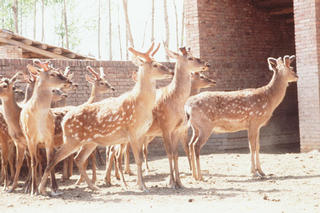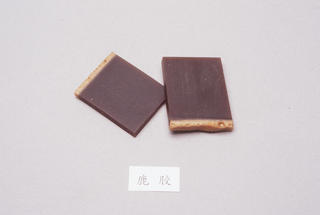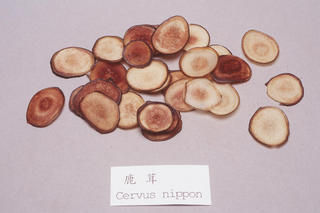Cervus nippon
Contents
Nomenclature
Other Names:
Historical Use of Cervus nippon
Cervus nippon in Traditional Chinese Medicine
Background
Chinese Name (pinyin): Lujiao
Chinese Name :
Common Name :Deerhorn (Antler)
Specific Name : Cornu cervi
Scientific Name:
Collection : The drug is collected in spring, removed from mud and sand and dried in the air.
Description : Malujiao Branched: Usually divided into 4-6 branches, 50-120cm in total length, the main branched curve 3-6cm in diameter with a plate like protuberance at the basal part commonly known as "Zhenzhupan" (pearl plate) usually with sparse small pores at the margin of the plate. The side branches mostly stretched toward one side. The first side branch near the pearl plate and the second near the first. Externally greyish-brown or greyish-yellow, lutrous, tip smooth, the middle and the lower parts usually with warty tubercles known as "Guding" (bony nail) and longitudinal ridges. Texture hard, The outer part of the fracture bony, greyish white or slightly brown, the central part usually greyish brown with honeycomb like pores, odourless, taste, slightly salty.Meihualujiao: usually divided into three to four branches, 30-60cm in toatl length, 2.5-5cm in diameter. The side branches mostly stretched towards two sides. The first side branch near the pearl plate, the second relatively apart from the first. The end of the main branch divided into two small branches. Externally yellowish-brown or greyish-brown the end greyish white with distinct bony nails at the lower end of the branches, arranged in discontinued longitudinal ridges. The tip of the bony nails greyish-white or greyish-yellow, lustrous.Lujiaotuopan: In helmet or flattened helmet, 3-6cm in diameter (pearl plate 4.5-6.5 cm in diameter), 1.5-4cm high. Externally greyish-brown, lustrous. The middle portion with honeycomb-like minute pores. Bottom surface even, honeycomb-like, mostly yellowish white or yellowish-brown. The margin of the pearl plate usually with sparse small pores. The upper surface slightly even or irregular semispheroidal in shape. Texture hard, the outer part of the fracture bony, greyish-brown, central part whitish, odourless, taste slightly salty.
Identification :
Processing : Wash clean, saw into sections, soak in warm water, take out, cut into slices and dry in the shade or powder with a file.
Action : To warm the kidney and stengthen the tendons and bones, and to promote blood circulation and cause subsidence of swelling.
Indication :
Precautions : (1) Colla Cornus Cervi. (2) Corus Cervi Degelatinatum.
Dosage : 6 to 15 g.
Storage : Preserve in a dry place.
Nomenclature
Other Names:
Historical Use of Cervus nippon
Cervus nippon in Traditional Chinese Medicine
Background
Lurongfen ¹È×·Û
Lurongpian ¹È×Ƭ
Chinese Name (pinyin): Lurong
Chinese Name :
Common Name :Pilose Antler
Specific Name : Cornu cervi pantotrichum
Scientific Name:
Collection : The drug is collected in summer and autumn, processed and dried in tha shade or dried by heat.
Description : Hualurong Branched, cylindrical. The antler with one side branch known as "double branches" (Ergang), the main branch as "big branch" (Dating), 17-20cm long, cut surface 4-5cm in diameter, the side "side branch" (Menzhuang), 9-15cm long, slightly smaller than "Dating " in diameter. The outer skin reddish-brown or brown, usually lustrous, densely covered with reddish yellow or brown yellow soft hairs, relatively thick at the upper end and sparse at the lower end, with greyish black vein at the base between the main and side branches.. The skin and hairs nestling closely to each other. The cut surface yellowish-white, without bony element in the outer part. Small pores densely distributed in the central portion, light. Odour, slightly stinking, taste slightly salty. The antler with two side branches commomly known as "triple branches" (sacha), Dating 23-33cm long and smaller than that of "Ergang" in diameter, slightly bow shaped and flattened, the tip slightly pointed, lower part usually bearing longitudinal ridged veins and lumps. The skin reddish-yellow, soft hairs relatively sparse and wide. The autumn pilose antler similar to the summer pilose antler but "Dating" is longer and not round or lower part wider than the upper part, the lower part with longitudinal ridged veins. Skin greyish-yellow, soft hairs relatively thick. The outer part of the cut surface usually ossified, rather heavy, no stinking odour.Malurong: larger and wider than Hualurong, more branchred. The antler with one or more side branchescommonly known as "single side branch" (Danmen), lotus (lianhua), Tripple side branches (Sancha) and Quadruple side branches (Sicha) respsectively. Also refered as "east re deer pilose antler (Dongmalurong)" and "west red deer pilose antler (Ximalurong)" according to the originalities.Dong Malurong: The "Dating" of the "Danmen" of 25-27cm long, about 3cm in diameter, The outer skin greyish black, soft hairs greyish brown or greysih yellow. The outer skin of the cut surface rather thick greyish black. The central portion of the cut surface densely distribuited with small pores. Texture of the "Danmen" tender. The "Dating" of the Lianhua" up to 33cm long with ridged veins at the lower part, the cut surface with relatively larger honeycomb-like pores. The skin of "Sancha" dark texture rather tough. The "Sicha" with sparse and wide soft hairs, the lower part of the "Dating" with ridged veins and lumps, tip usually lacking soft hairs, commonly known as "hairless tip" (Niantou).Xi Malurong: "Dating" 3-100cm long, usually not round, tip round or flattened. The surface with ridges but usually shrunken and shrivelled. The branches rather long and curved, the soft hairs wide and long, grey or greyish-black. The cut surface with relatively dark colour and bony elements. Odour, stinking, taste salty.
Identification : 1.To about 0.1g of the powder add 4ml of water, heat for 15 minutes, cool and filter. To 1ml of the filtrate add 3 drops of ninhydrine TS, mix well, boil for several minutes, a bluish violet colour is produced. To 1ml of the filtrate add 2 drops of 10% sodium hydroxide solution and 0.5% cupric sulfate solution dropwise, a bluish violet colour is produced.2.To 0.4g of the powder add 5ml of 70% ethanol, ultrasonicate for 15 minutes, filter and use the filtrate as the test soluiton. Prepare a solution of 0.4g cornu Cervi Pantotrichum reference drug in the same manner as the reference drug solution. Dissolve glycine CRS in 70% ethanol to produced a solution containing 2mg per ml as the reference solution. Carry out the method for thin layer in the chromatography (appendix Vl B) using silica gel G containing carboxymethylcellulose sodium as coating substance nbutanol-glacial acetic acid-water (3:1:!) as the mobile phase. Apply separately to the plate 10µl of the test solution and 1µl of the reference solution. After developing and removal of the plate, dry it in the air. Spray with 2% solution of ninhydrin in acetone and heat at 105ºC for several minutes. The main spots in the chromatogram obtained with the test solution correspond in position and colour to the spots in the chromatogram obtained with the reference drug solution. The pink spot due to glycine in the chromatogram obtained with the test solution correspond in position and colour to the spot in the chromatogram obtained with reference solution.
Processing : Cornu Cervi Pantotrichum (sliced): Burn away the soft hairs, scrape clean, wrapped it with a clothing band, add hot white rice wine into to the small holes on the cut surface until it is softened thoroughly or steam briefly after filled with wine, cut into slices, press and dry.Pulvis Cornis Cervi Pantitrichi: Burn away the soft hairs, scrape clean, split into pieces and pulverize.
Action : To promote virility, replenish vital essence and blood, and strengthen the tendons and bones, to regulate the mreidians related to the uterus and conception, and promote the bursting of abscess and drainage of pus.
Indication : impotence, spermatorrhea, or frigidity and infertility; emaciation, lassitude, aversion to cold, dizziness, tinnitus, impairment of hearing, back pain accompanied by cold sensation, and weakness of the limbs; abnormal uterine bleeding and leukorrhea; chronic cores difficult to heal
Precautions :
Dosage : 1 to 2 g, to be ground into fine powder and taken liquid with it.
Storage : Preserve in well closed containers, stored in a cool and dry place, protected from moth.
Synonymns for Cervus nippon
Patent Medicines and Medicines with Multiple Ingredients that include Cervus nippon
Pharmaceutical Information
Chemical Constituents
Evidence or the Use of Cervus nippon in the Treatment of Epilepesy
Basic Science
Animal Studies
Cohort, Case-Control and Non-Randomized Trials
Randomized Controlled Trials
Meta-Analysis
1st Five Results: pubmed search
Yong-Su Park, Min-Gee Oh, Sang-Hwan Kim
iSCNT embryo culture system for restoration of Cervus nippon hortulorum, presumed to be sika deer in the Korean Peninsula.
PLoS One: 2024, 19(4);e0300754
[PubMed:38635543]
[WorldCat.org]
[DOI]
(I e)
Jeong Hoon Pan, Min Kook Lee, Moon Han Chang, Liana N Crowley, Brandy L Le, Da Seul Lee, Tae Gyun Kim, Dahye Kim, Kangwook Lee, Seong-Gyu Ko, Jin Hyup Lee, Suk Hee Lee, Jae Kyeom Kim
##Title##
Food Sci Biotechnol: 2024, 33(7);1671-1683
[PubMed:38623429]
[WorldCat.org]
[DOI]
(I e)
Hai-Qin Zhou, Feng Hai, Jian-Hong Hu, Song Li, Sheng-Jun Chen, Kai-Xue Zhang, Meng-Juan Cheng
[Identification of Cervi Cornu (Cervus elaphus) and its formula granules based on PCR-RFLP].
Zhongguo Zhong Yao Za Zhi: 2024, 49(6);1517-1525
[PubMed:38621935]
[WorldCat.org]
[DOI]
(P p)
Seiki Takatsuki, Masakazu Inaba
Food Habits of Raccoon Dogs at An Agricultural Area in Shikoku, Western Japan.
Zoolog Sci: 2024, 41(2);185-191
[PubMed:38587913]
[WorldCat.org]
[DOI]
(I p)
Yan Wu, Shuting Zhao, Peihe Zheng, Hanlu Liu, Zhengyi Qu, Wei Hou, Weitao Yuan, Tao Feng, Xiaofeng Zhan, Jinlong Shen, Kaiying Wang
##Title##
Front Microbiol: 2024, 15;1344905
[PubMed:38544859]
[WorldCat.org]
[DOI]
(P e)



